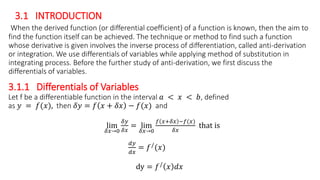Report
Share

Recommended
More Related Content
Similar to theorey of ch 3.pptx
Similar to theorey of ch 3.pptx (20)
Complex differentiation contains analytic function.pptx

Complex differentiation contains analytic function.pptx
Statistical Inference Part II: Types of Sampling Distribution

Statistical Inference Part II: Types of Sampling Distribution
DSP_FOEHU - MATLAB 02 - The Discrete-time Fourier Analysis

DSP_FOEHU - MATLAB 02 - The Discrete-time Fourier Analysis
Existance Theory for First Order Nonlinear Random Dfferential Equartion

Existance Theory for First Order Nonlinear Random Dfferential Equartion
Matrix Transformations on Some Difference Sequence Spaces

Matrix Transformations on Some Difference Sequence Spaces
PPT Antiderivatives and Indefinite Integration.pptx

PPT Antiderivatives and Indefinite Integration.pptx
Presntation for the post of lecturer in Mathematics

Presntation for the post of lecturer in Mathematics
Recently uploaded
Recently uploaded (20)
Presentation by Andreas Schleicher Tackling the School Absenteeism Crisis 30 ...

Presentation by Andreas Schleicher Tackling the School Absenteeism Crisis 30 ...
Measures of Central Tendency: Mean, Median and Mode

Measures of Central Tendency: Mean, Median and Mode
General Principles of Intellectual Property: Concepts of Intellectual Proper...

General Principles of Intellectual Property: Concepts of Intellectual Proper...
ICT role in 21st century education and it's challenges.

ICT role in 21st century education and it's challenges.
On National Teacher Day, meet the 2024-25 Kenan Fellows

On National Teacher Day, meet the 2024-25 Kenan Fellows
Web & Social Media Analytics Previous Year Question Paper.pdf

Web & Social Media Analytics Previous Year Question Paper.pdf
Measures of Dispersion and Variability: Range, QD, AD and SD

Measures of Dispersion and Variability: Range, QD, AD and SD
Mixin Classes in Odoo 17 How to Extend Models Using Mixin Classes

Mixin Classes in Odoo 17 How to Extend Models Using Mixin Classes
Ecological Succession. ( ECOSYSTEM, B. Pharmacy, 1st Year, Sem-II, Environmen...

Ecological Succession. ( ECOSYSTEM, B. Pharmacy, 1st Year, Sem-II, Environmen...
Asian American Pacific Islander Month DDSD 2024.pptx

Asian American Pacific Islander Month DDSD 2024.pptx
Russian Escort Service in Delhi 11k Hotel Foreigner Russian Call Girls in Delhi

Russian Escort Service in Delhi 11k Hotel Foreigner Russian Call Girls in Delhi
This PowerPoint helps students to consider the concept of infinity.

This PowerPoint helps students to consider the concept of infinity.
theorey of ch 3.pptx
- 1. 3.1 INTRODUCTION When the derived function (or differential coefficient) of a function is known, then the aim to find the function itself can be achieved. The technique or method to find such a function whose derivative is given involves the inverse process of differentiation, called anti-derivation or integration. We use differentials of variables while applying method of substitution in integrating process. Before the further study of anti-derivation, we first discuss the differentials of variables. 3.1.1 Differentials of Variables Let f be a differentiable function in the interval 𝑎 < 𝑥 < 𝑏, defined as 𝑦 = 𝑓(𝑥), then 𝛿𝑦 = 𝑓 𝑥 + 𝛿𝑥 − 𝑓(𝑥) and lim 𝛿𝑥→0 𝛿𝑦 𝛿𝑥 = lim 𝛿𝑥→0 𝑓 𝑥+𝛿𝑥 −𝑓(𝑥) 𝛿𝑥 that is 𝑑𝑦 𝑑𝑥 = 𝑓/(𝑥) dy = 𝑓/ 𝑥 𝑑𝑥
- 2. 3.1.2 Distinguishing Between 𝛅𝒚 and 𝒅𝒚. The tangent line is drawn to the graph of 𝑦 = 𝑓(𝑥) at 𝑃(𝑥, 𝑓 𝑥 ) and MP is the ordinate of P, that is, 𝑀𝑃 = 𝑓(𝑥). (see Fig. 3.1) Let δ𝑥 be small number, then the point N is located at x + δ𝑥 on the x-axis. Let the vertical line through N cut the tangent line at T and the graph of f at Q. Then the point 𝑄 is (𝑥 + 𝑑𝑥, 𝑓(𝑥 + 𝑑𝑥)), so 𝑑𝑥 = 𝛿𝑥 = 𝑃𝑅 and δ𝑦 = 𝑅𝑄 = 𝑅𝑇 + 𝑇𝑄 δ𝑦 = 𝑇𝑎𝑛𝜑𝛿𝑥 + 𝑇𝑄 ∴ 𝑇𝑎𝑛𝜑 = 𝑅𝑇 𝑃𝑅 where 𝜑 is the angle which the tangent 𝑃𝑇 makes with the positive direction of the 𝑥 − 𝑎𝑥𝑖𝑠. 𝑜𝑟 𝑑𝑦 = 𝑓 ‘ 𝑥 𝑑𝑥 + 𝑇𝑄 ∴ tan 𝜑𝑑𝑥 = 𝑓 ‘ 𝑥 ⇒ 𝛿𝑦 = 𝑑𝑦 + 𝑇𝑄
- 3. 3.1.2 Distinguishing Between 𝛅𝒚 and 𝒅𝒚. We see that dy is the rise of f for a change dx in x at x where as dy is the rise of the tangent line at P corresponding to same change 𝛿𝑥 in x. As dx approaches 0, the value of 𝑑𝑦 gets closer and closer to that of δ𝑦, so for small values of δ𝑥, 𝑑𝑦 = 𝛿𝑦 or 𝑑𝑦 = 𝑓 ‘ 𝑥 𝑑𝑥 ∴ 𝑑𝑦 = 𝑓 ‘ 𝑥 𝑑𝑥 We know that δ𝑦 = 𝑓 𝑥 + 𝑑𝑥 − 𝑓 𝑥 𝑓 𝑥 + 𝑑𝑥 = 𝑓 𝑥 + 𝛿𝑦 But 𝑑𝑦 ≈ 𝑑𝑦 𝑠𝑜 𝑓 𝑥 + 𝑑𝑥 ≈ 𝑓 𝑥 + 𝑑𝑦 𝑓(𝑥 + 𝑑𝑥) ≈ 𝑓(𝑥) + 𝑓 ‘ (𝑥)𝑑𝑥
- 4. Example 1: Use differentials to approximate the value of 17 . Solution: Let 𝑓(𝑥) = 𝑥 Then 𝑓 (𝑥 + 𝑑𝑥) = 𝑥 + 𝛿𝑥 As the nearest perfect square root to 17 is 16, so we take x = 16 and δ𝑥 = 𝑑𝑥 = 1 Then 𝑦 = 𝑓(16) = 16 = 4 Using 𝑓 (𝑥 + 𝑑𝑥) ≈ 𝑓 (𝑥) + 𝑑𝑦 𝑓 (𝑥 + 𝑑𝑥) ≈ 𝑓(𝑥) + 𝑓 ‘ (𝑥) 𝑑𝑥. ∴ 𝑓/ 𝑥 = 1 2 𝑥 𝑓 (16 + 1) ≈ 𝑓(16) + 1 2 16 × (1) 𝑓 17 ≈ 4 + 1 2 × 4 = 4 + 1 8 = 32 + 1 8 = 33 8 Hence 17 ≈ 4.125 Answer